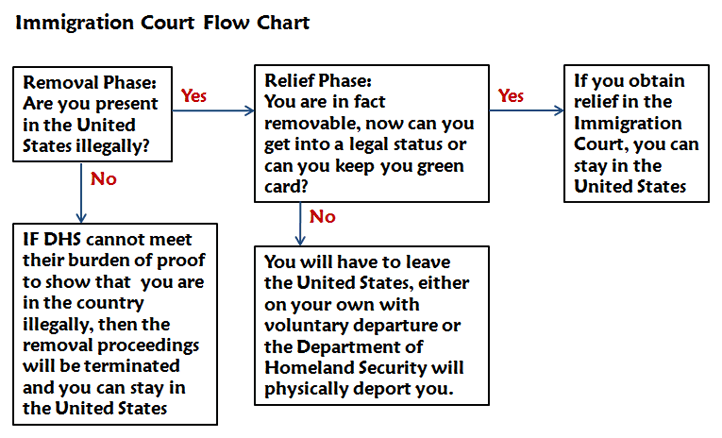Introduction
If you are in removal or deportation proceedings, then you will need an attorney to help you defend against deportation. Deportation proceedings arise when a person is present in the United States in violation of the immigration laws. Deportation proceedings are best understood as two distinct proceedings: the removal phase and the relief phase. In the removal phase, the Department of Homeland Security (DHS) has the burden to prove that you are in fact in the United States in violation of the immigration laws. If you are found removable, then you will need to find a form of relief to stay in the United States.
Immigration Court Flow Chart

Removal Phase – Why are you in deportation proceedings?
Removal Phase For Non-Residents
Typical grounds of removability for non-residents (the following list is not by any means an exhaustive list, but merely some of the most typical grounds of removability for non-residents):
- If you entered the United States without being admitted or inspected by an immigration official?
- If you entered the United States with a temporary visa and overstay the visa without extending it?
If you are not in a legal status and you come to the attention of the Department of Homeland Security (DHS), then DHS will often (although not always) put you removal proceedings. The key issue is whether you can get into a legal status during the relief phase of the removal proceedings.
Removal Phase For Residents
Typical grounds of removability for residents (the following list is not by any means an exhaustive list, but merely some of the most typical grounds of removability for green card holders):
- If you were convicted of a crime that makes you deportable?
- If you made a misrepresentation when you got your green card?
- If you forget or willfully fail to file something that you were supposed to file when you got your green card?
- If you either forgot or willfully failed to disclose negative information when you got your green card?
You already have a legal status and DHS is now seeking to revoke your legal status. If you have committed a crime, please go to the Crimes and Immigration page. For issues related to your green card, there may be a way to defeat DHS’s allegations of removal. Otherwise, if DHS proves that you are deportable, then you will have to seek relief, typically (and hopefully) LPR cancellation of removal.
Relief Phase – Can I get relief from deportation and remain in the United States legally?
At this point, DHS has proven that you are removable. Now, can you get relief from removal? You can try to keep your green card through cancellation of removal for lawful permanent residents or with a waiver. If you are not eligible for cancellation or a waiver, it is possible that you will lose your green card. Either way, you must find a way to get into a legal status. The following are the various methods that the firm uses to Beat Deportation and get you into a legal status.
Cancellation of Removal for green card holders
Cancellation is available for green card holders, but you must have already been in the United States for over 7 years in some legal status. Crimes and other negative factors can make you ineligible for this type of relief.
Cancellation of Removal for non-residents
Cancellation of removal is available for non-citizens who are not lawful permanent residents, but you must have already been in the United States for over 10 years and have a citizen or green card holder relative – spouse, parent, or child. Crimes and other actions indicating bad moral character can made you ineligible for this type of relief.
Adjustment of status
Adjustment of status permits a you to get a green card based on a petition from an employer or a family member. Even if you previously had a green card, this type of relief is still available in certain circumstances. You must be admissible to the United States. If not, you will need a waiver. Long term legal status is available in certain circumstances to non-citizens who are eligible for NACARA – Nicaraguan Adjustment and Central American Relief Act. In addition, residency is available for refugees and asylees, and generous waivers are available to refugees and asylees.
Temporary Protected Status
Depending on which country you are from, you may qualify to stay in the United States for a specified period of time under the Temporary Protected Status (TPS) program. TPS is typically implemented by the DHS and the Department of State for a short period of time based on difficulties such as diseases, conflicts, and/or natural disasters in your country of origin. TPS does not grant permanent legal status, but you can obtain work authorization documents as long as the TPS period is authorized. Crimes and serious traffic convictions can bar eligibility. In addition, the TPS recipient can travel abroad with an advanced parole document (WARNING: because there are risks to traveling abroad on TPS advance parole, you should always consult with an attorney before leaving the United States).
Visas
In certain circumstances, you might be eligible for a visa. If you were the victim of a particular crime, you might be eligible for a U Visa. If you the victim of trafficking, you might be eligible for a T- Visa.
DACA
DACA is no longer available for initial applications, but current DACA recipients can renew their DACA applications.
Asylum, Withholding of removal, and protections under the Convention Against Torture
If you have suffered past persecution in your home country or country of last habitual residence, or you have a well-founded fear of future persecution in your home country or country of last habitual residence and such persecution is based on race, religion, nationality, political opinion or membership in a particular social group, you may be eligible for asylum and/or withholding of removal. Persecution can take many forms and typically encompasses harm and other forms of physical abuse, but it can also include wrongful prosecutions, imprisonment, economic (or other forms of) deprivation, and subtler forms of torture.
You must apply for asylum within one year of your entry into the United States. There are exceptions, but they are very limited. If you did not apply for asylum within the one year deadline, you can still apply for withholding of removal.
If you will be subject to torture upon return to your home country, you can seek protection under the Convention Against Torture and Other Cruel, Inhuman or Degrading Treatment or Punishment. For refugees and asylum seekers, this is a relief of last resort, but not insignificant.
With asylum, you can eventually get a green card. Withholding and CAT protection will permit you to remain in the United States and get a work authorization, but you cannot get any further benefits.
What if I cannot get into a legal status or keep my legal status?
At this point, you are going to receive an order of removal. As a relief of last resort, you can apply for voluntary departure, which will allow you to leave the United States on your own terms. You will have a limited time, up to 60 days (120 days if you chose to apply for voluntary departure before the relief stage), to depart the United States. But, you will not have a deportation on your record. Importantly, if you have no intention of voluntarily leaving the United States, do not apply for voluntary departure because you will incur negative penalties if you fail to leave the United States during the voluntary departure period.
If you do not wish to get voluntary departure, you will have an outstanding order of deportation. At that point, the Department of Homeland Security will then try to physically deport you back to your home country.





